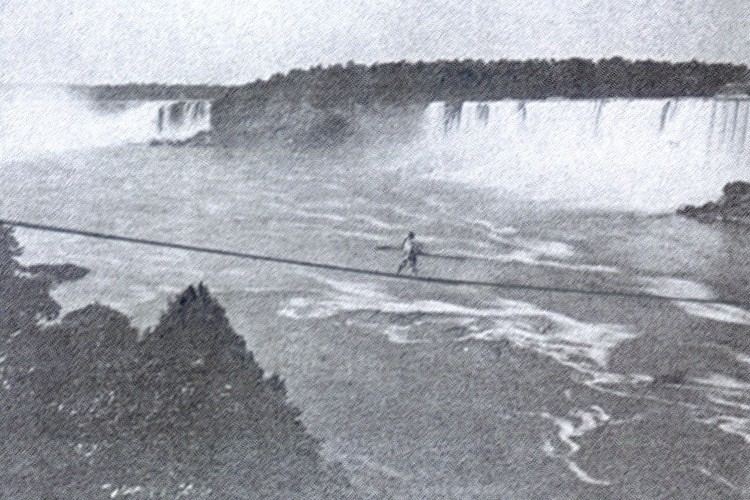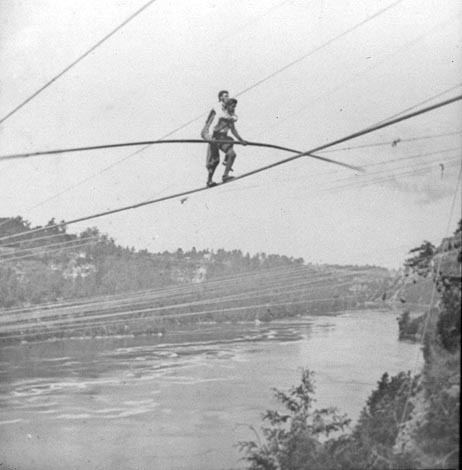Name Charles Blondin | ||
 | ||
Born 28 February 1824 ( 1824-02-28 ) Died February 22, 1897, Ealing, London, United Kingdom | ||
The charles blondin wheelbarrow story
Charles Blondin (born Jean François Gravelet, 28 February 1824 – 22 February 1897) was a French tightrope walker and acrobat.
Contents
- The charles blondin wheelbarrow story
- Charles blondin illustration
- Early life
- North America
- Britain and Ireland
- Later years and death
- Legacy
- References

Charles blondin illustration
Early life

Blondin was born on 28 February 1824 at St Omer, Pas-de-Calais, France. His real name was Jean-François Gravelet and he was known also by the names Charles Blondin, Jean-François Blondin and called the "Chevalier Blondin", or simply "The Great Blondin". At the age of five he was sent to the École de Gymnase at Lyon and, after six months training as an acrobat, made his first public appearance as "The boy Wonder". His superior skill and grace, as well as the originality of the settings of his acts, made him a popular favourite. He first married Marie Blancherie, and at the same time legitimised their son Aime Leopold. It is not known what happened to his French family after he went to America.
North America

Blondin went to the United States in 1855. He was engaged by William Niblo to perform with the Ravel troupe in New York City and was subsequently part proprietor of a circus. He especially owed his celebrity and fortune to his idea of crossing the Niagara Gorge (located on the Canada–US border) on a tightrope, 1,100 ft (340 m) long, 3.25 in (8.3 cm) in diameter and 160 ft (49 m) above the water, near the location of the current Rainbow Bridge. This he did on 30 June 1859, and a number of times thereafter, always with different theatrical variations: blindfolded, in a sack, trundling a wheelbarrow, on stilts, carrying a man (his manager, Harry Colcord) on his back, sitting down midway while he cooked and ate an omelette and standing on a chair with only one chair leg on the rope.

While in the US he married a second wife, Charlotte Lawrence, with whom he had Adele c. 1854, Edward c. 1855 and Isis c. 1861.
Britain and Ireland
In 1861, Blondin first appeared in London, at the Crystal Palace, turning somersaults on stilts on a rope stretched across the central transept, 70 feet (21 m) from the ground. In 1862, he again gave a series of performances at the Crystal Palace, and elsewhere in England, and on the continent of Europe.
In September 1861 he performed in Edinburgh, Scotland at the Royal Botanic Gardens (then called the Experimental Gardens) on Inverleith Row.
In 1861, he performed at the Royal Portobello Gardens, on South Circular Road, Portobello, Dublin, on a rope 50 feet (15 m) feet above the ground. While he was performing, the rope broke, which led to the scaffolding collapsing. He was not injured, but two workers who were on the scaffolding fell to their deaths. An investigation was held, and the broken rope (reported as 2 inches (5 cm) in diameter and 5 inches (13 cm) in circumference) examined. No blame was attributed at the time to either Blondin or his manager. However, the judge said that the rope manufacturer had a lot to answer for. The organiser of the event, a Mr. Kirby, said he would never have another one like it. A bench warrant for the arrest of Blondin and his manager was issued when they did not appear at a further trial (they were in America). However, the following year, Blondin was back at the same venue in Dublin, this time performing 100 feet (30 m) above the ground.
On 6 September 1873, Blondin crossed Edgbaston Reservoir in Birmingham. A statue built in 1992 on the nearby Ladywood Middleway (52.476656,-1.925325) marks his feat.
While he was living in England he and Charlotte had two more children, Henry, born about 1863, and Charlotte Mary Janet, baptised on 25 April 1866.
Later years and death
After a period of retirement, Blondin reappeared in 1880, including starring in the 1893/4 season of the pantomime "Jack and the Beanstalk" at the Crystal Palace, organised by Oscar Barrett.
Charlotte, his wife, died in 1888. In 1895, he married again. His third wife, Katherine James, had nursed him through a back injury earlier that year. His final performance was in Belfast in 1896.
Blondin died of diabetes at his "Niagara House" in Ealing, London, on 22 February 1897, in his 73rd year, and was buried in Kensal Green Cemetery. His estate at death was valued at £1,832 (£187 thousand as of 2015). Although much younger, his widow survived him by only four years, dying of cancer in 1901 at the age of 36.
Legacy
During his lifetime, Blondin's name was so synonymous with tightrope walking that many employed the name "Blondin" to describe others in the profession. For example, there were at least five people working with variations of the Blondin name in Sydney in the 1880s, the most famous of whom was Henri L'Estrange—"the Australian Blondin". So popular had tightrope walking become, that one Sydney resident wrote to the Sydney Morning Herald to complain of "the Blondin business" that saw people walking on high wires wherever the opportunity arose. He noted that he had seen one walking on a wire in Liverpool Street in the city with a child strapped to his back. The practice which had become so popular was both dangerous and, the correspondent thought, likely to be unlawful, particularly in the risk of harming others. In reporting on the fall of a woman from a tightrope at an 1869 performance of Pablo Fanque's Circus in Bolton, the Illustrated London News described the tightrope walker, Madame Caroline, as a "female Blondin".
Two streets in Northfields, Ealing, London, are named in his honour: Blondin Avenue and Niagara Avenue; they were formerly the site of part of Hugh Ronalds' renowned nursery.
During the run-up to the Presidential election of 1864, Abraham Lincoln compared himself to "Blondin on the tightrope, with all that was valuable to America in the wheelbarrow he was pushing before him". A political cartoon appeared in Harper's Weekly on 1 September 1864 depicting Lincoln on a tightrope, pushing a wheelbarrow and carrying two men on his back—Navy Secretary Gideon Welles and War Secretary Edwin Stanton—while "John Bull", Napoleon III, Jefferson Davis (representing the nations of England, France, and the Confederate States, respectively), and Generals Grant, Lee and Sherman (representing the military) looked on, among other onlookers.
